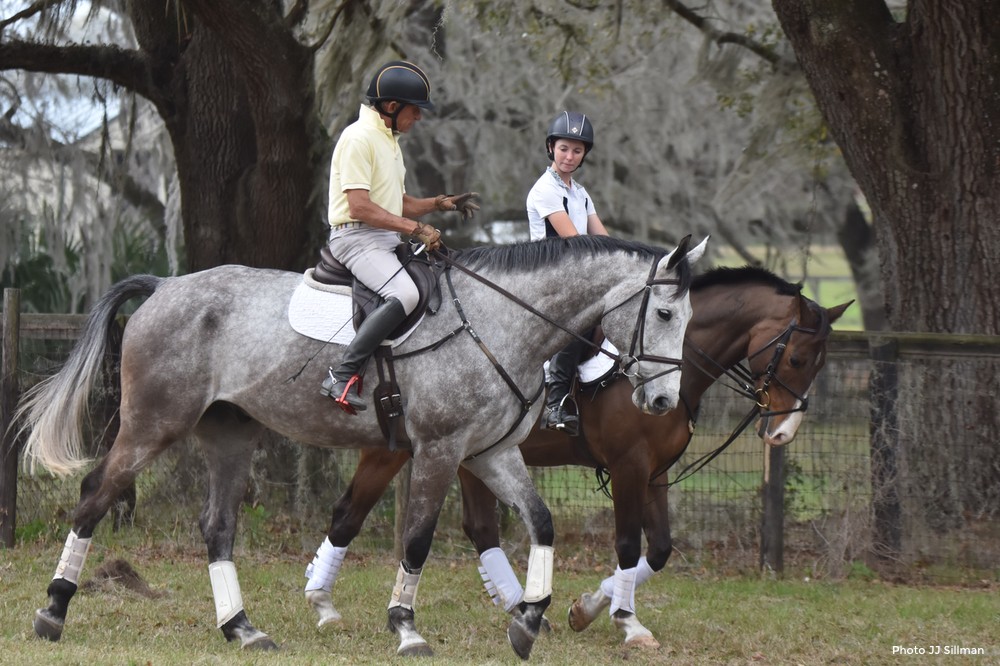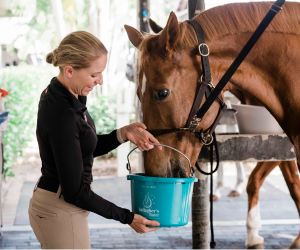Fundamentals: How Bruce Davidson Starts Young Horses

Bruce Davidson has been breeding event horses for 40 years at Chesterland Farm in Unionville, Pa. As the winningest event rider in the history of the sport in the U.S., Bruce knows all the right ingredients to make a top event horse. His Chesterland-bred progeny are now competing at the three- and four-star level, proving Bruce’s ability to choose bloodlines for talent and ability.
But Lee Camiolo, who helps get youngsters at Chesterland started under saddle, says it’s not all nature. The ‘nurture’ matters, too.
“The Chesterland babies have really good heads on their shoulders,” said Lee, 17, of Louisville, Ky., who has been working with Bruce for three years. “But Bruce has taught me how to properly ride a baby because getting them started correctly is so important for the rest of their careers. Patience can really make or break them.”
Lee has always had an interest in developing young horses which led her to compete in the Extreme Mustang Makeover – where riders have 100 days train a wild mustang before showcasing their partnership in front of a crowd – prior to joining Bruce’s team and competing through the Intermediate level of eventing. Lee gave Heels Down Mag the inside scoop on how Bruce Davidson develops his young horses to have long, successful careers in eventing.
The First Steps
Before they begin training, foals, yearlings and two-year-old horses grow up in a natural environment out at pasture, which promotes growth, strength, and calm minds in the young horses.
“They get weaned at the appropriate age – typically around nine months or so – but they still will live out(side),” Lee explained. “At Chesterland, the facility is immaculate and there are so many fields for the babies, so they start their lives living in green pastures.”
Around the age of two, the horses will start to learn the routine of coming into the barn.
“We start getting them out of the field, putting halters on them, and then they start learning the routine of being put in a stall, being groomed, maybe wearing a saddle or saddle pad. It’s all very low stress.”
Lee says that the Chesterland staff makes a point of handling the young horses routinely. The horses come to expect that they will be led around the barn, desensitized to grooming tools and tack, and therefore, it becomes a less nerve-wracking situation when it’s time for tack to be worn and work to begin.
Rider Up
Once they are between two and three years old, the youngsters learn the next step: how to carry a rider. But first, they must learn to wear a bridle – Bruce doesn’t care for teaching this after introducing the rider.
“He likes to have a bridle on when you get on the first time. He likes for everything to be cut and dry and to get on with it. We use very soft bits – just a snaffle. The rider is first introduced in a stall with a handler on the ground. The stall provides a small, controlled environment that the horse is already accustomed to.
“The handler will give you a leg up. And you’ll do small circles in the stall so you have a controlled environment. From there, depending on how the baby is reacting to that environment, you’ll move out to a round pen or an indoor – something that can be closed in case of a situation.”
“A situation” – i.e., a horse bucking or bolting – can happen at a moment’s notice with young horses, so no rider at Chesterland mounts a young horse without a grab strap. The riders also use breastplates to keep the saddle secure, and wear body protectors in case of an unexpected dismount.
“(A grab strap) is something that we do not go without, even on the most trustworthy babies. Because you never know.”
The Crucial Fundamentals
The most important lesson a newly-broken youngster can learn is the “go” button.
“The biggest thing is that they learn that your leg means go. That’s something that they have no concept of – your legs don’t mean anything at first,” Lee said. “So reinforcing that forward button is huge at that age and they carry that with them their whole lives.”
Around age three or four, they will go off-site for their first show or off-site venture. While most of the Chesterland babies are remarkably calm, which is rare in such young horses as Lee explains, it’s important not to feed into any nerves a young horse might have.
“You can’t let your instinct take over. If they spook, you have to be their guidance,” she said.
These days, Bruce himself isn’t the test cowboy on youngsters that are experiencing a rider on their backs for the first time. But he’s often on the ground helping to foster a safe and calm experience, reinforce the forward aids, and guide the rider in how to react.
“Bruce’s program for young horses is unlike anything I’ve ever seen, at least,” Lee admits. “Besides being a champion at that the highest levels of eventing, he really specializes in his young horses and his group of stock that he has coming up the levels.”


